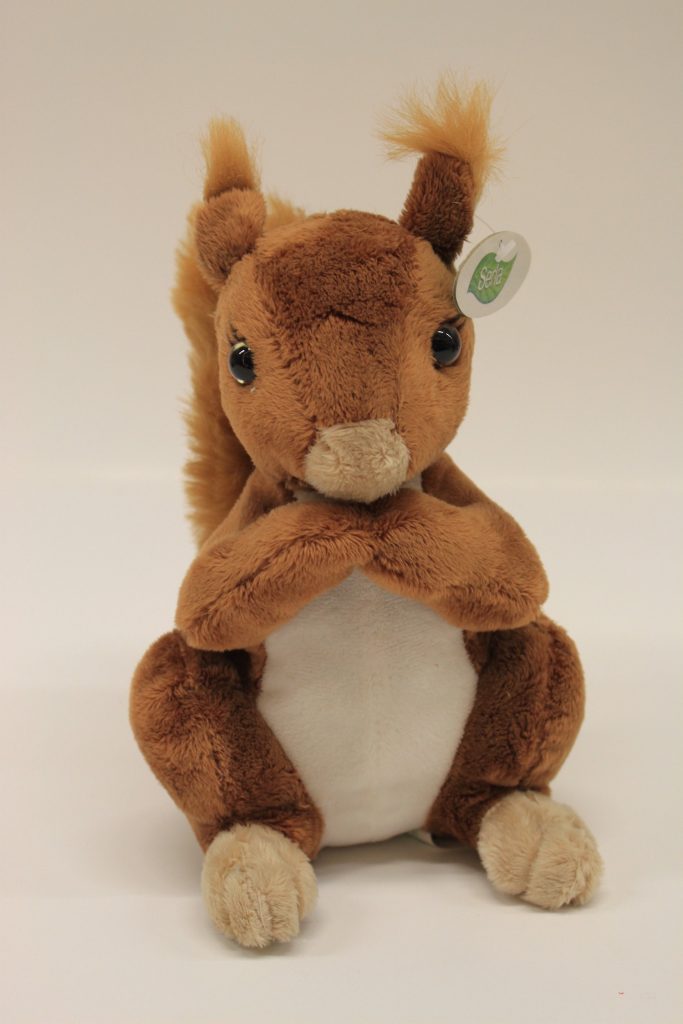Serla Squirrel – a mascot used in marketing
NOVEMBER 2018
The object collection of the Serlachius Museums contains 43 Serla soft toy squirrels, with whose “siblings” hundreds of thousandsFinnish children have played. However, children’s play is not the intended use of the museum squirrels nor the reason for their maintenance in the collection. In fact, no-one has played with them. A well-known character printed on Serla Tissue products and used in marketing campaigns, the Squirrel forms a part of the 150 year-long history of Metsä Tissue Mänttä mills. It also communicates of consuming and regulation of marketing.
Serla soft toy squirrels entered the households early 21st century. In year 2001, a change in the consumer legislation came to force that facilitated the marketing aided with the so-called free gifts. Until then, a consumer product that had no “imminent factual link” to the promoted product must not be offered as a free gift dealt out free of charge or on reduced price. A suitable free gift for toilet paper or kitchen rolls might have been a roll holder, but handing out soft toys would, however, not have complied with the law. As manufacturer of Serla products, Metsä Tissue made use of the change in law by commencing a collecting campaign.
Plastic wrappings for Serla tissue paper manufactured at the Mänttä mills were provided with cut-out ‘collect and get’ tags that consumers could trade for squirrel products. Already during the first campaign, Metsä Tissue traded 245 000 squirrels to Finnish homes for collecting tags. The packaging of the soft toys made in China was carried out with the help of scout groups that used this as a means of fund raising. At some stage the squirrels were packaged under vacuum so that they could be mailed in a letter.
Collecting the squirrel soft toys can also be seen in reference to other phenomena of consumption and trading. Collecting tags is a natural continuum of cutting out coupons from magazines. During the era of print media, an advertisement of a retailer could entail several coupons that you needed to present in order to receive a discount in a price. “Coupons” bought consumer goods and groceries, whose present-day discount prices rely on customer loyalty programmes or are valid during particular period of time. Along with the digitalization, collecting of tags has changed so that cutting out and posting the tag has been substituted by codes that need to be entered.
Squirrels in object collection of the Serlachius Museums tell about the 21st-century collecting culture. Cutting out tags has been considered a way to utilise the acquired product as effectively as possible, to receive some kind of item for free, against a small effort and at the price of a stamp. Some may have collected the items out of habit and not for the sake of being rewarded; tags may have been left to wait for the next campaign or give or sell to others.
Because the squirrel products have become sought-after collectibles, the tags have been high in demand. Serla Squirrel can be characterised as blockbuster that has been acquired for the sake of itself and not just because it has been free of charge. During the campaigns, a vast amount of paper may have been stocked up in order to get a specific squirrel soft toy. There are also stories about tags having been cut out of the packages that were still on the shop shelve.
Serla Squirrel is a collectible item that is closely linked to the marketed brand. Squirrel has been a well-known character in product packages and marketing for a couple of decades. It has been clear for the consumer that one must buy the product in order to get the squirrel. During the Serla collecting campaign, a consumer may have created a several-year-long connection to the manufacturer of the Serla tissue papers. In order to get the benefit, the squirrel has been a reward for the commitment to the product called Serla, rather than to a certain shop chain or retailer, which is often the case in some other types of collecting.
Milla Sinivuori-Hakanen
Curator


